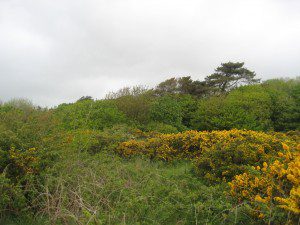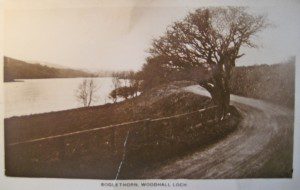This is the month with the longest day, so I make no apology for this post being somewhat longer than the usual. I want to give you a good flavour of June in Crockett’s Galloway. In the short story‘A Cry Across the Black Water’ he drops us immediately into the scene:
It was at the waterfoot of the Ken, and the time of the year was June.
‘Boat ahoy!’
What follows is a strange and supernatural tale. You can find it in the collection ‘Bog Myrtle and Peat.’ But when I think of Crockett and June in Galloway, my thoughts are neither with the supernatural, nor with his natural description, wonderful though that is;
It was yet very early, though the stir of awakening life began, in those days of mid June, before even the dews of evening had time to cake the dust on the roads.
No, in June, my thoughts immediately turn to one of Crockett’s most engaging characters Kit Kennedy. Kit is a loose fictional representation of Crockett himself. And because I can think of nothing better to do on a sunny day in June than imagine childhood in Galloway, here is part of a chapter, where Kit and his dog Royal play truant from school and go swimming in Grenoch Loch for you to enjoy:
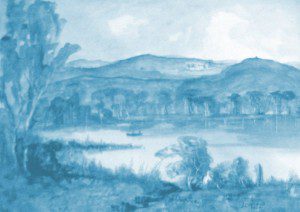 [picture loch Grenoch, Copland]
[picture loch Grenoch, Copland]
CHAPTER TWENTY TWO
THE TWO TRUANTS
Kit Kennedy was playing truant. The fact is sad, but it must not be blinked. It was a glorious day in June, and the water of Loch Grenoch basked blue and warm in the eighteen-hour-long sunshine. Also Royal was with him, his great red collie, whose left-hand connection with the laird of Craes Newfoundland was suspected on strong presumptive and circumstantial evidence. Royal, however, like most mixed races, was of a joyous disposition, and questions of pedigree did not trouble him. That he should have a blue-blooded Newfoundland or another to his father was all the same to Royal. He had even been known to ‘down’ his putative parent on the open street of Whinnyliggate and to take unfilial toll of his ear, for the first commandment with promise is not of any canine acceptation.
This day, however, he had assuredly led Kit Kennedy astray. The boy had left the cottage in the wood in the most meek and obedient frame of mind. He even ran over the multiplication table as far as nine times nine so quickly that it sounded like the gurring of a sewing-machine in rapid action. It was no use going further, for ten, eleven, and twelve times are too easy to be required seriously of babes, while thirteen times is impossible even to chartered accountants.
Kit proceeded as far as the road end of Crae before letting his good intentions falter. This was the precise distance that Betty Landsborough’s sugar ‘piece’ lasted him.
Mistress Armour did not approve of spoiling boys, and would have sent Kit off empty-handed. But Betty thought otherwise. She continued the plan of Kit’s mother on his first day of school, and her foolish extravagance was connived at by Matthew the Elder.
So every morning when Kit set out for Whinnyliggate —that is, every day except Saturday and Sunday—Betty spread a scone with butter, and upon the butter, with no illiberal hand, she showered a coating of sugar, thick, brown, and gritty as the desert of Sahara. To Kit’s unsophisticated palate the combination constituted the food on which angels grew their wings.
But at the end of the little straight avenue, which led from the cottage door to the pine-edged road, the tempter was lying in wait. Royal, whose position in the family was now purely supernumerary, had vanished from the green in front upon the first appearance of Kit Kennedy at the door with Betty, who was concealing the sugar piece under her apron from Mistress Armour, while that shrewd lady occupied a position of observation in the rear.
So at the end of the road Royal waited on his prey.
Kit caught sight of him and whistled joyously. The dog curved his tail and came bounding up to the boy to beg for ‘scone.’ He had had his breakfast, and he privately despised sugar, except perhaps in lumps and of the best white quality.
But he wanted Kit Kennedy to come down and play with him on the lochside. And so, as Kit himself would have said, Royal ‘let on’ to like it.
The tempter gambolled in front, barking joyously. He said as plain as print, ‘Now then, we’re off! Hurrah for the water!’
But for awhile—for at least as much as a quarter of an hour—Kit manfully resisted. By that time a considerable distance had been put between the cottage and the wayfarers. The loch was very blue beneath. The little waves sparkled distractingly. The wind waved the yellow broom in a way it really ought not to. The universe was ill-arranged for a small boy attending school that day.
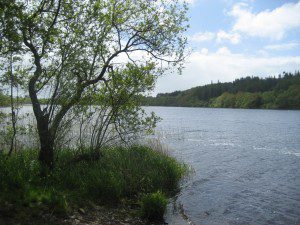 [picture – Woodhall loch today]
[picture – Woodhall loch today]
Kit is not Crockett’s first manifestation of his younger self. In ‘A Galloway Herd,’ which was pulled together from a series of short sketches from as early as 1891and turned into an episodic novel never published in the UK (until last year), Crockett can be seen in the young Wattie Anderson, a boy who turns the dullest of realities into romantic fiction. Crockett describes Wattie, lost and asleep out on the Galloway hills.
The June nights are merciful in Galloway, and it was not long before a broad bar of light lay across the eastern hills which shut out the plains of the Dee and the long glen of the Ken. The pale sea-green lingering in the west had not yet faded into ashy gray when the eastern sky began to flame. The clouds in the east through which the sun rose were long and parallel like ocean rollers combing towards a sandy shore, while the clouds of the sunset converged to a point as though the sun draws them flaming after him with the speed of his downward rush. Suddenly up sprang the sun over the low rounded summits to the south, and the shadows of every bush of bog myrtle and tuft of heather started westward, and the cool, blue image of a lonely upright boulder, like a Breton menhir, lay for half a mile across the heather. On the sunny side of this landmark the red rays fell on a bare and curly head, on which the dew sparkles just as it does on the yellowish gray bent upon which it is pillowed. Apparently the flaxen fleece which covers it is a sufficient protection, for the boy has taken his bonnet off and covered his feet with it. He lies curled up like a collie sleeping in the sun. He continues to sleep quietly and soundly with the undisturbed repose of childhood till the dew dies from off the heath and from the angles of sunny hair.
Wattie is ‘found’ by Mr Durand and Crockett tells us that:
Scented breaths of afternoon air blew in through the open window from the sun-warmed closes of the orchard. It was such a June day as comes but seldom in Scotland. Mr. Durand, with the far-away expression in his face, set himself to think how he would get news of this boy’s home, and how he would be returned thither; but he had no need to trouble himself, for even as the drowse of the day became too much for him, and he dozed over in his chair, a red farm cart lumbered up to the door, craunching in an unaccustomed manner on the gravel.
J.M.Barrie wrote that ‘genius is the rediscovery of the boy within us.’ Another contemporary critic wrote of Crockett’s work: ‘Genius it has been said, is only the faculty of recollecting in maturity the emotions of one’s childhood. One may well believe it as one read the pages of these books, which enshrine the wonder, the vitality, the immense zest of life’
Assuredly, Crockett delivers us the universality of childhood in his stories, taking us to an emotional place we surely all remember and cherish in some way or to some degree however far behind us it is. Time changes both people and places and in Crockett’s own day, Grenoch Loch had been renamed as Woodhall. In his non-fiction book, ‘Raiderland’ he writes:
It is vain, I fear, to call it Grenoch—as it should be called. A certain name-changing fiend brought into our Erse and Keltic Galloway a number of mongrel names, probably some Laird Laurie with a bad education and a plentiful lack of taste, who, among other iniquities, called the ancient Clachan-of-Pluck after himself—Laurieston. His mansion-house he changed from the ancient and honourable ‘Grenoch,’ by which name it stands in Pont’s map of (about) 1611, to the commonplace Woodhall. Later the loch had a like fortune. Loch Grenoch became Woodhall Loch (or in the folk speech of the parish, Wudha’ Loch)…
…But Woodhall Loch (after you have become accustomed to the barbarism) smells as sweet, and its water ripples as freshly as ever did that of Loch Grenoch—which at least is some comfort.
Crockett describes how to get there…
Setting out northward away from Laurieston, there lie before you five miles of the most changefully beautiful road in Scotland, every turn a picture, and in the season every bank a wonder of flowers… The first mile to the beginning of the loch itself is through scenery curiously reminiscent of some parts of central France—the valley of the Creuse, for instance, George Sand’s country—or some of the lower tributaries of the Tarn. The tall poplars in front of the ruined smithy, the little burn that trips and ambles for a few hundred paces beside the traveller and then is lost, hurrying off into the unknown again as if tired of being overlooked—all these are more French than Scottish.
Myriads of wild flowers throng on every side, at all seasons of the year when wild flowers can be found in Scotland— indeed many even in winter.
…Farther along is Blates Mill, where (so they tell me) one Leeb M’Lurg put up her remarkable notice concerning eggs, and held her siege against her weazel-faced uncle Tim, ere the bull did its ultimate justice upon him.
…Yet a little farther on, its branches bent by the furious blasts from the loch, stands at an angle of the road, the famous Bogle Thorn. It seems somehow to have shrunk and grown commonplace since I used to pass it at a run, with averted eyes, in the winter gloamings on my way home from school…
He confesses,
…Woodhall Loch is like many another. Half its beauty is in the seeing eye. Yet not only the educated or the intellectual may see.
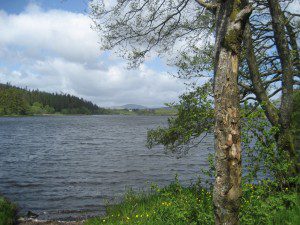 [picture, where Bogle Thorn used to be]
[picture, where Bogle Thorn used to be]
You can find Woodhall Loch easily enough on the A713 (but walk down to the river away from the parking places for the best view). The Bogle Thorn is sadly no more, a victim of road straightening. But there is plenty more to appreciate on the road to New Galloway including Blates Mill, Copland’s house and Crae Bridge itself. So why not get out and explore the Glenkens of Crockett’s childhood this June for real, and/or through his fiction.
‘Raiderland,’ ‘Bog Myrtle and Peat,’ ‘Kit Kennedy’ and ‘A Galloway Herd’ are all available as paperback or ebooks from The Galloway Raiders online store www.gallowayraiders.co.uk So if you’re looking for some summer reading this June, why not pay it a visit and pick up some Galloway childhood memories. Then lie back and enjoy the long days of a Galloway summer.
Written for DGWGO by Cally Phillips


